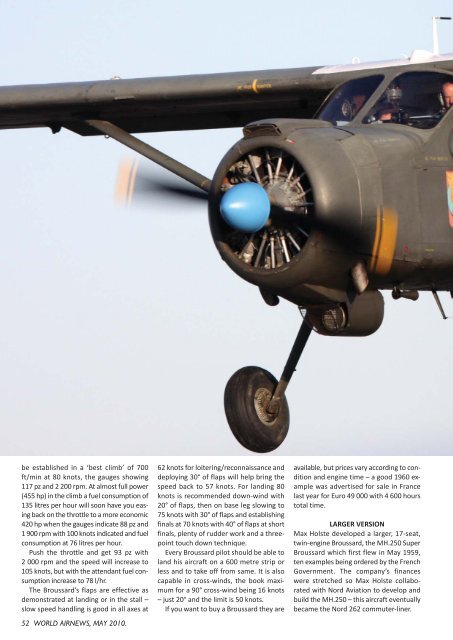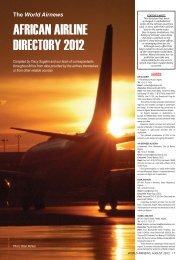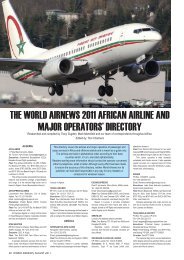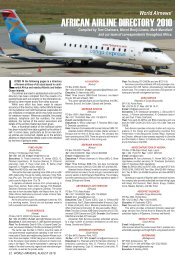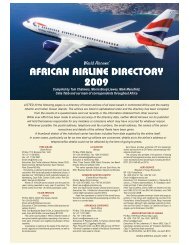May 2010 covers_Covers.qxd - World Airnews
May 2010 covers_Covers.qxd - World Airnews
May 2010 covers_Covers.qxd - World Airnews
You also want an ePaper? Increase the reach of your titles
YUMPU automatically turns print PDFs into web optimized ePapers that Google loves.
e established in a ‘best climb’ of 700<br />
ft/min at 80 knots, the gauges showing<br />
117 pz and 2 200 rpm. At almost full power<br />
(455 hp) in the climb a fuel consumption of<br />
135 litres per hour will soon have you easing<br />
back on the throttle to a more economic<br />
420 hp when the gauges indicate 88 pz and<br />
1 900 rpm with 100 knots indicated and fuel<br />
consumption at 76 litres per hour.<br />
Push the throttle and get 93 pz with<br />
2 000 rpm and the speed will increase to<br />
105 knots, but with the attendant fuel consumption<br />
increase to 78 l/hr.<br />
The Broussard’s flaps are effective as<br />
demonstrated at landing or in the stall –<br />
slow speed handling is good in all axes at<br />
52 WORLD AIRNEWS, MAY <strong>2010</strong>.<br />
62 knots for loitering/reconnaissance and<br />
deploying 30° of flaps will help bring the<br />
speed back to 57 knots. For landing 80<br />
knots is recommended down-wind with<br />
20° of flaps, then on base leg slowing to<br />
75 knots with 30° of flaps and establishing<br />
finals at 70 knots with 40° of flaps at short<br />
finals, plenty of rudder work and a threepoint<br />
touch down technique.<br />
Every Broussard pilot should be able to<br />
land his aircraft on a 600 metre strip or<br />
less and to take off from same. It is also<br />
capable in cross-winds, the book maximum<br />
for a 90° cross-wind being 16 knots<br />
– just 20° and the limit is 50 knots.<br />
If you want to buy a Broussard they are<br />
available, but prices vary according to condition<br />
and engine time – a good 1960 example<br />
was advertised for sale in France<br />
last year for Euro 49 000 with 4 600 hours<br />
total time.<br />
LARGER VERSION<br />
Max Holste developed a larger, 17-seat,<br />
twin-engine Broussard, the MH.250 Super<br />
Broussard which first flew in <strong>May</strong> 1959,<br />
ten examples being ordered by the French<br />
Government. The company’s finances<br />
were stretched so Max Holste collaborated<br />
with Nord Aviation to develop and<br />
build the MH.250 – this aircraft eventually<br />
became the Nord 262 commuter-liner.


